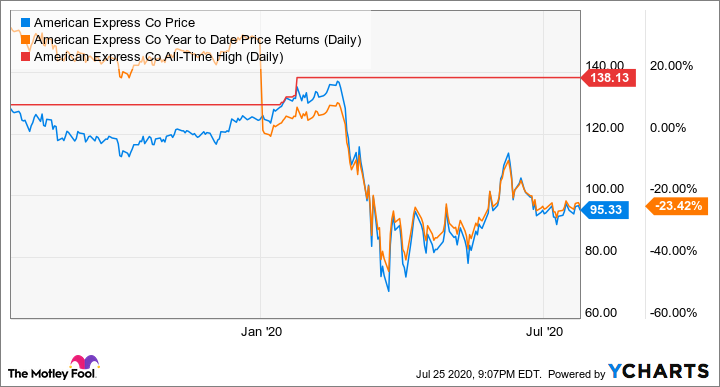Shares of American Express (AXP 0.07%) were little changed after the company reported its second-quarter earnings last week and are still down more than 23% year to date and 40% from their February high.
Unsurprisingly, AmEx reported fairly downbeat results for the second quarter, as higher-margin travel and entertainment spending fell precipitously. That segment of spending accounted for roughly 30% of AmEx customer total spending heading into the quarter, skewing higher compared with other credit card companies.
In fact, AmEx's revenue fell by almost exactly the proportion of travel and entertainment spend, down 29.1% in the quarter, missing analyst expectations. However, AmEx also beat expectations for earnings per share, recording a profit of $0.29, as the company reserved less than Wall Street analysts had predicted. That could either be seen as a positive that AmEx is seeing its loans and card receivables holding up better than expected, or as a negative, in that it may have to take additional reserves later on.
Taking the former view, management pointed to several reasons things may be better across AmEx's loan portfolio than some may have feared. In addition, AmEx highlighted several ways in which it was pivoting the company's benefits away from travel and entertainment and toward the stay-at-home economy.

Image source: Getty Images.
Management feels good about reserves, even though they were lower than expected
During the quarter, American Express recorded $1.56 billion in loan losses, consisting of $927 million in write-offs and $628 million in an extra reserve build. That built upon the extra $1.7 billion reserve build taken at the end of the first quarter.
Management updated its outlook to take into account a higher level of unemployment compared with three months ago, now predicting an unemployment rate of 15%-17% in the second quarter and gradually improving to 9%-11% by the fourth quarter, up from last quarter's projections of 9%-13% unemployment in Q2 improving to 7%-9% by Q4.
However, now that it's taken the extra reserve build, management feels good about its current reserves for the remainder of the year, with the potential of a new federal stimulus bill giving these credit metrics potential upside. Management was keen to point out the amount of loans and receivables in one of the company's relief programs had fallen from $11.5 billion at the end of the first quarter to just $5 billion at the end of the second, which perhaps speaks to the quality of American Express' prime customer base.
Can AmEx get spending back?
American Express shareholders should thus feel good about loan losses, especially since the company only gets about a quarter of revenue from interest income. More important is getting customer and business spending back. That spending was down 33% across all of American Express' segments in the second quarter, though it was improving through the quarter to exit June, "just" down 25%.
Fortunately, AmEx isn't standing still and is quickly pivoting from a travel-and-entertainment benefit focus to one more tailored to the stay-at-home economy. The company rolled out short-term benefit programs across categories such as grocery and food delivery, streaming subscriptions, and other essentials. Most notable is the company's new Shop Small initiative, in which card members can earn $5 off purchases over $10 at most small businesses near them up to 10 times this summer, for a total of $50 off. As a cardholder myself, I've already taken advantage of this several times, as I've been ordering a lot from local restaurants since the pandemic began.
There's also evidence these programs may be bearing fruit. Though AmEx's total card spending is still down, non-travel and entertainment spending actually turned positive year over year in July. Through the first half of the month, non-travel and entertainment spending was up 5% over July 2019, even as total spending remained down about 20%. Travel and entertainment spending remains a stunning 75% lower compared with last year.
Looking like a good value here
While no one likes to see revenue declines and reserve builds, AmEx is in little danger of having any sort of liquidity problems for the foreseeable future. Its capital ratios increased during the quarter as total loans came down, and it appears the company's underwriting was conservative heading into the crisis. AmEx's relief programs also seem to be working, and management is pivoting to spur more non-travel and entertainment spending while travel and leisure activities remain depressed.
The financial sector is one of the more beaten-down sectors in the market amid COVID-19; however, large financial companies like American Express that will survive the pandemic are more likely than not to look like good values once a COVID-19 treatment or vaccine is developed, which should hopefully be within the next year.






